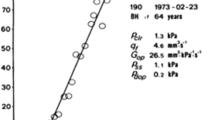Abstract
Background
The intracranial pressure (ICP) is usually continuously monitored in the management of patients with increased ICP. The aim of this study was to discover a mathematic equation to express the intracranial pressure–volume (P–V) curve and a single indicator to reflect the status of the curve.
Methods
Patients with severe brain damage who had bilateral external ventricular drainage (EVD) from December 2008 to February 2010 were included in this study. The EVD was used as drainage of CSF and ICP monitor. The successive volume pressure response [6] values were obtained by successive drainage of CSF from ICP 20–25 to 10 mmHg. Parabolic, exponential, and linear regression models were designed to have a single parameter as the indicator to determine the P–V curves.
Results
The mean of parameter “a” in the exponential equation is 1.473 ± 0.054; in the parabolic equation, it is 0.332 ± 0.061; and in the linear equation, it is 1.717 ± 0.209. All regression equations of P–V curves had statistical significance (p < 0.005). Parabolic and exponential equations are closer to the original ICP curve than linear equation (p < 0.005). There is no statistically significant difference between parabolic and exponential regressions.
Conclusions
The P–V curve can be expressed with linear, parabolic, and exponential regression models in increased ICP patients. The parabolic and exponential equations are more accurate methods to represent the P–V curve. The single parameter in the three regression equations can be compared in different conditions of one patient in clinical practice.

Similar content being viewed by others
References
Avezaat CJJ, van Eijnbhoven JHM, Wyper DJ (1979) Cerebrospinal fluid pulse pressure and intracranial volume–pressure relationships. J Neurol Neurosurg Psychiatry 42:687–700. doi:10.1136/jnnp.42.8.687
Guillaume J, Janny P (1951) Manometric intracanienne continue interet de la method et premiers results. Rev Neurol (Paris) 84:131–142
Lofgren J, von Essen C, Zwetnow NN (1973) The pressure–volume curve of the cerebrospinal fluid space in dogs. Acta Neurol Scand 49:557–574. doi:10.1111/j.1600-0404.1973.tb01330.x
Marmarou A, Shulman K, Rosende RB (1978) A nonlinear analysis of the cerebrospinal fluid system and intracranial pressure dynamics. J Neurosurg 48:332–344. doi:10.3171/jns.1978.48.3.0332
Marmarou A, Beaumont A (2004) Physiology of the cerebrospinal fluid and intracranial pressure. In: Winn HR (ed) Youmans neurological surgery, 5th edn. Saunders, pp 175–193
Miller JD, Garibi J, Pickard JD (1973) Induced changes of cerebrospinal fluid volume. Arch Neurol 28:265–269
Miller JD (1975) Volume and pressure in the craniospinal axis. Clin Neurosurg 22:76–105
Ryder HW, Espey FF, Kimbell FD, Penka EJ, Rosenaue RA, Podolsky B, Evans JP (1953) The mechanism of the change in cerebrospinal fluid pressure following an induced change in the volume of the fluid space. J Lab Clin Med 41:428–435
Sklar FH, Elashvili I (1977) The pressure–volume function of brain elasticity. Physiological considerations and clinical applications. J Neurosurg 47:670–679. doi:10.3171/jns.1977.47.5.0670
Sklar FH, Beyer CW Jr, Vlark WK (1980) Physiological features of the pressure-volume function of brain elasticity in man. J Neurosurg 53:166–172, 10.3171/jns.1980.53.2.0166
Shapiro K, Marmarau A, Shulman K (1980) Characterization of clinical CSF dynamics and neural axis compliance using the pressure–volume index: I. The normal pressure–volume index. Ann Neurol 7:508–514. doi:10.1002/ana.410070603
Sullivian HG, Miller JD, Becker DP, Flora RE, Allen GA (1977) The physiological basis of intracranial pressure change with progressive epidural brain compression. An experimental evaluation in cats. J Neurosurg 47:532–550. doi:10.3171/jns.1977.47.4.0532
Tans JTT, Poortvliet DCJ (1982) Intracranial volume–pressure relationship in man. Part I: calculation of the pressure–volume index. J Neurosurg 56:524–528. doi:10.3171/jns.1982.56.4.0524
Tans JTT, Poortvliet DCJ (1983) Intracranial volume–pressure relationship in man. Part II: clinical significance of the pressure-volume index. J Neurosurg 59:810–816. doi:10.3171/jns.1983.59.5.0810
Acknowledgments
The authors would like to thank Professor David J. Fairholm (Professor, Department of Neurosurgery, University of British Columbia ) for his advice and comments and Miss She-Hung Chan for her statistical assistance. The study was supported by the Chang Gung Medical Research Council (grant no. CMRPG 371581). No commercial party having a direct financial interest in the results of the research supporting this article has or will confer a benefit on the authors or any organization with which the authors are associated.
Conflicts of interest
None.
Author information
Authors and Affiliations
Corresponding author
Additional information
Comments
This is an interesting paper rich of valuable theoretical information on the pathophysiology of elevated intracranial pressure and its bedside measurement and interpretation. We think, however, that the message put forward by this article could be made more reader friendly if the paper “part 2,” which we think will provide correlations with the clinical conditions and outcome, was presented along the present one.
Domenico d’Avella
Mario Ermani
Padova, Italy
ClinicalTrials.gov Identifier: NCT01126658
Rights and permissions
About this article
Cite this article
Lai, HY., Lee, CY., Hsu, HH. et al. The intracranial volume pressure response in increased intracranial pressure patients: Part 1. Calculation of the volume pressure indicator. Acta Neurochir 154, 2271–2275 (2012). https://doi.org/10.1007/s00701-010-0765-8
Received:
Accepted:
Published:
Issue Date:
DOI: https://doi.org/10.1007/s00701-010-0765-8




